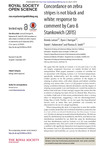Please use this identifier to cite or link to this item:
http://lib.hpu.edu.vn/handle/123456789/23703Full metadata record
| DC Field | Value | Language |
|---|---|---|
| dc.contributor.author | Larison, Brenda | en_US |
| dc.contributor.author | Harrigan, Ryan J. | en_US |
| dc.contributor.author | Rubenstein, Daniel I. | en_US |
| dc.date.accessioned | 2016-10-11T05:37:57Z | |
| dc.date.available | 2016-10-11T05:37:57Z | |
| dc.date.issued | 2015 | en_US |
| dc.identifier.other | HPU4160619 | en_US |
| dc.identifier.uri | https://lib.hpu.edu.vn/handle/123456789/23703 | en_US |
| dc.description.abstract | We agree that the results of Larisonet al.[1]andCaroet al.[2] are largely congruent—however, we remain divided on their interpretation. Both papers assessed a number of variables for an association with striping. Larisonet al.[1] found temperature, specifically isothermality and the coldest temperature of the coldest quarter, to be the primary predictor of the degree of striping in plains zebra, with other climate and habitat variables playing very minor roles. | en_US |
| dc.format.extent | 2 p. | en_US |
| dc.format.mimetype | application/pdf | en_US |
| dc.language.iso | en | en_US |
| dc.subject | Biology | en_US |
| dc.subject | Concordance | en_US |
| dc.subject | Zebra stripes | en_US |
| dc.subject | Stankowich | en_US |
| dc.title | Concordance on zebra stripes is not black and white | en_US |
| dc.type | Article | en_US |
| dc.size | 246KB | en_US |
| dc.department | Education | en_US |
| Appears in Collections: | Education | |
Files in This Item:
| File | Description | Size | Format | |
|---|---|---|---|---|
| 0502_Concordance.pdf Restricted Access | 246.3 kB | Adobe PDF |  View/Open Request a copy |
Items in DSpace are protected by copyright, with all rights reserved, unless otherwise indicated.
